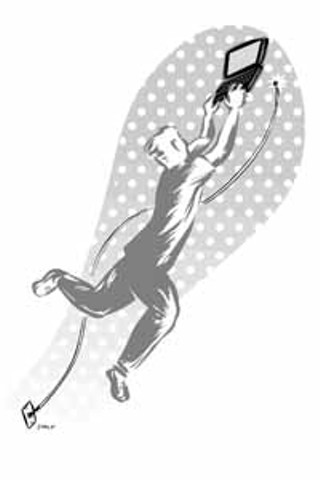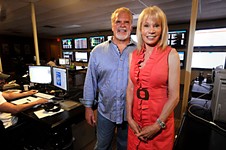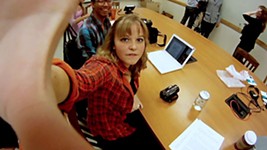Online, Unplugged
Is Wireless Internet the Ultimate Democratization of the Web?
By Michael Connor, Fri., April 26, 2002

Where do you keep your Internet?
In a small room at your house, on a table that's littered with breakfast taco wrappers? At the office, when the boss isn't looking? At the library, for designated one-hour blocks? The Internet doesn't just belong to a box, cube, or tower; it doesn't just belong in some back corner of your life. It belongs out in the world.
People need to communicate. In the most primal of ways, the success of the Internet is an extension of this need. Consider the two most popular Internet applications ever developed: instant messaging and e-mail. Because they fulfill this basic human need, they have the potential to become an organic part of our lives. And thanks to the increasing availability of wireless Internet access points, you can now find it for free at a growing number of businesses around Austin -- out from the cubicle, away from the breakfast taco wrappers, and into the world.
Scissors, Please
The next generation of Internet technology allows you to cut the cord. Known as 802.11b or wi-fi, this recent development in Internet access allows wireless-enabled computers and PDAs to connect via high-frequency radio waves to a central baystation at a range of up to 300 feet. The baystation, in turn, has a broadband connection to the Internet -- a good old-fashioned hard-wired one.
If you think you've got it good with the Sprint PCS wireless web on your Nokia, just wait until you see this. "It gives you the speed of no less than 11MB per second," explained Dan Vogler of the Austin Wireless Network, one of several Austin-based groups that promote wireless Internet access. "Even at the lowest speeds, that is 30% greater than a T1." And the range ought to be more than enough to cover the trip from the sofa to the refrigerator, even if you live on a sprawling compound in Crawford.
Wi-fi technology is experiencing an upsurge in popularity as the equipment gets cheaper. A radio card, which will make your laptop wireless-ready, can be found for about $60 these days, and even the baystations have become affordable for consumers. "It's only been recently (the past 18 months or so) that [the equipment] has become inexpensive enough that the everyday man and woman can equip their home and laptop with wireless LANs without taking out a second [mortgage] on their house," explained wireless Internet expert Jim Thompson of Musenki Technologies.
Still, it's not cheap enough for most local businesses to want to jump in and invest in the equipment, installation, and the commercial connection to get their patrons online. That's why the Austin Wireless Network started the "Wireless Everywhere for Everybody" program. The deal is simple, says Thompson. "[Businesses] pay for the (commercial) cable or DSL connection, and I'll provide the equipment." And the Austin Wireless Network installs it for free.
Spurred by a desire to make the Internet more accessible, Thompson plans to give away 20 of these wireless baystations, which retail for $700 apiece. "There is something about being on the Internet (at high speeds) without any wires (power, modem, Ethernet, etc.)," said Thompson in an e-mail. "I've tried to explain it for nearly four years now. The closest I've seen anyone come is to use the word 'Freedom' but that doesn't really explain the fundamental 'gestalt' of the experience."
Where It's At
One of the most recent beneficiaries of Thompson's generosity is, of all places, the Alamo Drafthouse North, where a wireless node was installed in time for the opening of techno-doc Revolution OS. In what may be the world's first wireless Internet-enabled movie theatre, patrons can now bring their laptops and get in a little IM time before the lights go down, without ever hooking up a wire. Where there was once uncomfortable silence, vintage TV commercials, and piped-in music, there will now be the soft clacking of laptop keys and the occasional quack of the alarm sound-du-jour.
The new access point goes beyond mere gimmickry, though. You do have to get a seat early for some of those weekend screenings, and the Drafthouse is planning to move some of the pre-movie entertainment from the silver screen to the LCD screen. "We're working on a couple of things for pre-movie entertainment, a couple of them are more interesting so it could be a great boon to have Internet access at your seat," said Tim League, owner of the Drafthouse.
With big-screen film and video projection, sound system, catering, and Internet access, the Alamo is positioning itself as a viable venue for business presentations. Film critics also stand to benefit from having Internet access at their seat in the theatre -- if they ever give up their notebook for an iBook, that is. "In general I think when a society requires more and more diversions at the same time, it's a sign that they're drinking from lead-lined aqueducts," said Roxanne Bogucka, a film critic for Hybrid Magazine.
When news of the installation broke on Internet geek forum Slashdot.com ("News for Nerds. Stuff that matters."), it elicited a lukewarm response from everyone except the copyright-infringement crowd, who seemed downright exuberant. "You could set up your laptop to encode the movie you're watching ... and STREAM it to people sitting in the next theatre over who were unfortunate enough to have bought tickets to see Queen of the Damned. Neat!" said one post to the forum.
Others were skeptical. "I love Internet ... I love Alamo Drafthouse ... I don't know if I love the two put together. The last thing I need is Mr. 'Noisy Typist' and Ms. 'I Refuse to Mute My Laptop' sitting next to me."
Just as people are beginning to discover the "vibrate" setting on their cell phones, the bar has been raised on movie-going etiquette. "We're not really advocating people having their laptops open during the movie," said League.
Free wireless Internet connections are already an institution at many noisier, more well-lit locales around Austin. For instance, at Hyde Park's scholarly Flight Path coffee shop, patrons regularly take advantage of the wireless Internet access, for all kinds of reasons.
"I come here because at home rats chewed up the wire," said Phil, a French grad student at UT. "So this is the simplest way to get to the Internet."
Wi-fi may be simple to use, but if it's security you're looking for, look elsewhere. The wi-fi transmissions are encrypted, but there's some debate about how secure they really are. "One should never consider the wi-fi security to be suitable," warns wireless Internet advocate Jim Choate. The best advice is to play it safe.
One reason for this is that it's not uncommon for cyber-geeks to drive around town by night, laptop at the ready, looking for a wi-fi LAN to tap into. "People have a variety of reasons, ranging from simple theft to technological wanderlust. The couple of times I've done it I've been wanting to know how dense the area was already covered," explains Choate. It's known as war-driving, and if you have a home 802.11b system you may be unwittingly providing free bandwidth to its practitioners. By using wi-fi, you gain privacy in one sense by avoiding using a traditional ISP, but you may be opening yourself up to snooping by techno-voyeurs.
Wireless users are quick to point out that this doesn't have to be a problem. "I am aware [of security issues], and for the things I'm doing I don't think it's that big of a worry," said Don, a theatre technician who uses the Internet connection at Flight Path. "I wouldn't use my credit card on a wireless connection or anything."
Turf Wars
Wireless Internet access points have a lot to offer users -- freedom, convenience, coffee, a relatively rat-free environment -- and they're a great way to connect multiple users in a concentrated area without a lot of expensive wiring. The technology doesn't make this wiring obsolete (after all, there still needs to be a hard-wired broadband connection), but it does provide a much-needed hedge against the increasing power of the phone and cable monopolies.
The 1996 Telecommunications Act created competition for both phone and cable by instituting "open access laws." In an effort to create competition for the Baby Bells, the FCC allowed businesses to make use of the existing telephone and cable lines and sell repackaged telephone and Internet services. This allowed independently owned Internet service providers, such as Earthlink, to sell Internet services over, for instance, BellSouth's phone lines.
Times have changed. The U.S. is past due for an overhaul of its telecommunications infrastructure, but phone and cable have been reluctant to invest in wires and routers that will benefit their open-access competitors nearly as much as it benefits themselves. So on March 14, the FCC ruled that cable Internet access is a "state-to-state cable service," and should be regulated differently than dialup access or DSL. In this reversal of policy, companies that resell telecommunications services are no longer considered to be viable competitors for Time Warner and the Baby Bells unless they build up and use their own infrastructure. In a statement, the FCC said that its intent was "to ensure that broadband services exist in a minimal regulatory environment that promotes investment and innovation." Translation: Time Warner won't have to share its shiny new wires with anyone.
"Congress and the FCC ... are denying [independent ISPs] access to cable networks. They're denying them access to telephone networks," says Scott McCullough, independent counsel for the Texas Internet Service Provider Association. "So wireless is going to be the last refuge of the independent ISP."
What the independent ISPs are hoping is that developers and business owners will realize that the monopolies' new wires may as well be rat bait when it comes to setting up a LAN, a computer network that is confined to a small area. Instead of, say, hard-wiring each apartment in your new high-rise for DSL, you can set up a wireless baystation and instantly connect them all.
Genie in a Bottle
As people find new ways to bring the Internet into the public sphere, old questions about the medium resurface. Notably, does it really facilitate communication, or does it just enforce isolation? After all, e-mail and IM eliminate the physical element of human contact. To misquote video artist Vito Acconci, the Internet is a rehearsal for a future in which we don't need a body.
"The Internet is basically 'anti-television,' despite what Hollywood is attempting," argues Thompson. "People have a fundamental need to communicate." And if text on a screen is really all we need -- if our fundamental need to communicate can be satisfied without any physical contact with another person -- then what happens when television and anti-television finally meet?
Dan Vogler sees wi-fi as a step toward the day when Internet and the television converge into one medium. "If we take everything that TV does and add Internet to it, TV will become a new animal. Something different than the TV we grew up with." Think instant access to every movie ever made. Think e-commerce, but on your television. Think choose-your-own adventure shows, or more likely choose-your-own-cliché. Think interactive TV.
If the current philosophy of the FCC persists, and cable monopolies in particular continue to be given widespread control over infrastructure and copyright, then we are looking at a future of increasingly powerful media gateways and a less democratic media culture -- a future against which the independent ISPs and Internet activists can only hope to hedge.
So is wireless Internet here to stay, or will it go the way of the carrier pigeon? A neat novelty act, or the changing face of technology, with implications we can only begin to understand? People are slowly catching on to wi-fi's selling points -- cost-effective, accessible, of the people rather than gouging the people -- and when the people go somewhere, the business world likes to be there first. Technological genies like this one don't go back into the bottle: They can only grow, evolve, and then be replaced. So go get your radio card, bub, prepare to retrofit your TV set and re-imagine what it means to communicate -- looks like wi-fi is the next big thing. ![]()










